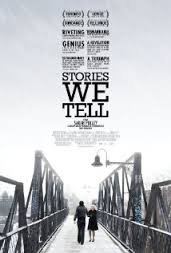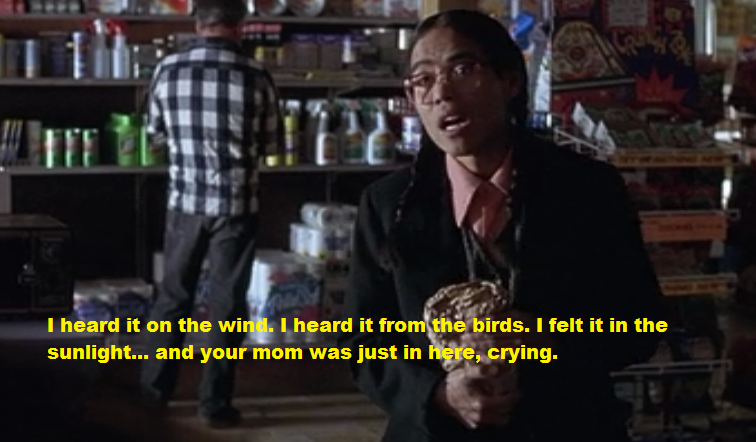Sarah Polley created a masterpiece named Stories We Tell, that exhibits a gallery of stories about Sarah’s mother Diane Polley and of herself. Sarah chose to film in a reflective documentary style, embodying all major aspects of the genre. Sarah utilizes her family and close friends of Diane to create the overall story, while capturing the entire filming process, and keeping skeptical of realism. The style suits the film most appropriately and I was able to place myself in the filming as if I was there. The film, and the style created a personal setting and I was immediately drawn into their story with utter curiosity. I counted 14 interviewers, including, Michael Polley, Harry Gulkin, all of Mike and Diane’s children, Diane’s friends and acquaintances, as well as Harry’s sister. The mash-up of different stories creates a very intriguing perspective into the way Sarah approaches her detective-like task. Since contradiction is common throughout the movie, the idea of who Diane truly was, is relative to all the stories. Polley captures important lessons such as: enjoying life, love, tracking time, and decision-making. The work embodies the reality of one’s adventure in life and how everyone has their own perspective of what is happening. In an interview with CBC News, Sarah outlines her goal. She states,”…what I wanted most was to examine the many versions of this story, how people held onto them, how they agreed and disagreed with each other, and how powerful and necessary creating narrative is for us to make sense of our bewildering lives. I wanted the story told in the words of everyone I could find who could speak about it.” It was beautiful creating the image of Diane, and not ever hearing her perspective on her own life. Sarah Polley portrays a wonderful, heart-warming story, and I continue to highly recommend it.
film
Indian Signals. Extra Blog- First Nations
Sherman Alexie is a Native American artist, who has written several Native- inspired novels and co-produced films, including Smoke Signals. In the film Smoke Signals, Victor Joseph and Thomas Build-the-Fire (two Native young men) venture from their reserve to Phoenix, Arizona, after receiving news about the death of Victor’s father. Alexie attempts to battle and poke fun at Native stereotypes, as well as remodel the idea of the modern Native. The movie is comical, yet serious therefore, it captivates the viewer and provides an insightful perspective of the story that has unfolded. Alexie uses humour to appropriately display his messages, and defeat stereotypes. In Kedong Lui and Hui Zhang’s paper, Self- and Counter-Representations of Native Americans: Stereotypical Images of and New Images by Native Americans in Popular Media, they mention,
“The white readers will often find that they are laughing at themselves. That laughter is part of the desired outcome of Alexie’s artistic strategy, for humor and laughter can relax readers and lure them to be off guard. Alexie observes, “People like to laugh, and when you make them laugh they listen to you. That’s how I get people to listen to me now” (as cited in Courtney-Leyba, 2001, p. 86). Humor makes readers accept the work readily, and the uncomfortable message would be only an after taste.”
Stereotypes are demonstrated throughout Smoke Signals, including the Indian as a noble warrior. During the film, Victor influences Thomas to change his look in order to look more Indian. Victor advises Thomas of 3 things: his hair must be let free (Thomas has cute braids in.), he must look mean so people respect him, and he needs to dress more casual (Thomas also has a cute suit on). Thomas attempts Victor’s look, however immediately after, Thomas and Victor encounter a couple of rude Americans who refuse to give Thomas and Victor’s seat back. This realization reflects how the Indian warrior look, gave them no respect to white Americans. At Victor’s father’s place, Thomas changes back to his regular attire and continues his journey, still as native as when he dressed more ‘’native.” All in all, the movie was humorous and effectively portrayed an integrated and respectful native figure.
The Act of Understanding How Sadistic a Human Really Can Be. Blog Assignment 5!
The Act of Killing portrays the collection of personal re-enactments from the Indonesian genocide in the mid- sixties. Joshua Oppenheimer takes the viewer on an emotional journey, providing an in-depth perspective of the actual scenarios that had occurred. I had never heard of the genocide before this film, and it was truly eye-opening. Oppenheimer had been working in the community for a couple months, and he shared the story of how the idea of the film began; in an interview with Adam Nayman from cinema scope.
“I took my camera and I went to the house of this person who had killed my friend’s aunt and I pretended that I was filming village life: children coming home with goats in the afternoon… He told me that he’d become the manager of the plantation because in 1965 he had been drowning hundreds of members of the plantation union. That was his preferred method. I recorded him describing this and showing me in his living room how he did it with some astonishment, not least of all because his nine-year-old granddaughter was sitting in the living room, bored, as if she’d heard it before.”
The traumatic events that seem to be ingrained in the modern Indonesian culture are shocking, and the portrayals provide vivid insight to the actual occurrences. Oppenheimer uses the observational documentary style to impact the viewers, actors, and the situation itself. Important aspects of observational documentaries include: the recognition of the director’s influence of the story and the utilization of film language and the medium of film as a tool for political and social activism. Oppenheimer uses the journey of story-telling and knowledge of an unrecognized historical event to take the viewer on an emotional and informative adventure.
In the film, Oppenheimer spends a large portion of his time with the main actor/ notorious gang leader and killer Anwar Congo. The viewer is introduced to Anwar as a happy man, on top of the world. He is excited about making a Hollywood film and he feels the need to share his “history” with the world. Anwar’s first re-enactment is astonishing, as he reveals to Oppenheimer how he would originally kill, the so-called “communists.” Only joy and celebration are expressed by Anwar; he even dances the cha-cha in the same spot he killed hundreds of people. The film opens the viewers to the atrocities committed and how no punishment has ever been assigned. Understanding that these men were able to get away with killing 2.5 million Indonesians, whether they were communist, Chinese immigrants, or even just too poor to pay their high demands, is a hard task to wrap your mind around. What blew my mind was how the media reacted to the film and the stories. As he described the events on live television, the host maintained a huge smile and expressed only curiosity and contentment. The fear from the genocide lives in most Indonesians and contributes to the way they function as a society. However, Oppenheimer’s story reveals the truth and guilt of Anwar as he re-lives all his past events as a youth. The emotional shift throughout the film is noticeably displayed, especially in the final scenes involving Anwar wandering around the same spot as the first re-enactment. His guilt had been shadowed for so many years, by his lack of fear and punishment and what Zizek considers self-interested egotism, so he would not feel the wrath of his wrong-doings. Oppenheimer uses the medium and the style of documentary to provide a ground-breaking and meaningful journey into history and genocide, and I recommend taking the time to watch the movie and understand it fully. It is amazing to realize what we are hidden from in the world.
Samson and Delilah: Coping with Nothing. Blog Assignment 4
Who doesn’t enjoy a love story?
Warwick Thornton takes a twist on the tale of Samson and Delilah, and creates a love story that tackles important issues of the modern Indigenous population. The movie takes place on a reservation near Alice Springs, Australia and revolves around the poverty- stricken community and their daily lives. The film is emotional roller coaster. The setting is a shocking display of desperation and despair, as Thornton provides an insight to the impoverished lifestyle of the modern native. I was appalled by the living conditions and how little of a community, the reservation actually was. The colonization of the reservation is also immediately apparent since all the natives are dressed like Australians with maybe the exception of Nana (Delilah’s grandma). The ignorance and disinterest of Indigenous culture is a misfortunate reality of our modern world. One of the most heart-breaking scenes, involves Delilah attempting to sell her art, to the same studio that displayed her Nana’s artwork, in order to provide some money for her and Samson. Her immediate rejection and the ignorance of the curator disturbed me and her reaction was powerfully expressed. The lack of dialogue is an interesting choice, and uses a mix of the Indigenous language and English as well. Susan Ryan-Fazilleau adds an interesting point on the use of dialogue in the film in her article, “Samson and Delilah: Herstory, Trauma and Survival.” She quotes, “Delilah and her nana speak in ‘language’—a vital sign of a living Indigenous culture.”
Trauma can have a drastic impact on one’s mental health, especially in the native community. Thornton does a fantastic job displaying the cruel effects trauma in Samson and Delilah. Samson is seen, living in the poorest of conditions, with no family support and what seems as an addiction to huffing petrol. The lack of family is completely destructive to a child growing up and a general lack of care for himself is evident from the fact. His brother neglects his existence, beating the poor boy who only seeks for attention and love from someone, anyone, even anything. His only belongings being the clothes on his back, his bed ( if you can call it a bed), a can of old petrol and a radio. I could feel the hopelessness that surrounding Samson’s everyday, and he copes with nothing and no one. What is really tore my heart out, was Samson’s ability to speak ,which was barely existent. The only dialogue, he actually speaks is a desperate attempt to say his name. Delilah,upon the death of her Nana, is needlessly beaten and accused of the maltreatment of her grandmother. The trauma which has struck their lives is too overwhelming for them, so they head to the city, with hopes of something better then what they had. They find a cozy sanctuary under a bridge with a homeless man, who cheerfully helps them on their new journey. I loved the addition of this character, because it shows that their is humanity left in the world and some people are willing to help. Trauma strikes in the city again however, as Delilah is kidnapped, beaten and presumably raped. However, the two teenagers with no one but each other, resort to addiction and spend most of the day huffing petrol or gasoline. The sad truth is the reality behind this scenario. Addiction destroys the lives of a large portion of the Indigenous population and is a symbol for the lack of support these individuals actually receive from their neighbours; a message Thornton accurately portrays.
In the end, the two go back to the reserve after Delilah is struck by a car on the highway by their bridge. Delilah, with her broken leg, rehabs Samson and creates a nice little home for the two of them by the reserve. The fight for survival and love, Delilah displays, is encouraging and inspiring, and I believe provides a positive and touching conclusion for the quite shocking film.
On a side note, here is an awesome song, that involves the story of Samson and Delilah.
Samson- Regina Spektor
https://www.youtube.com/watch?v=p62rfWxs6a8
Hope y’all enjoy.
Her.
Today I watched the film, Her directed by Spike Jonze. The story revolves around a man named Theodore who falls in love with his OS (Operating System- Like a computer) who has the capability of emotions, intuition and personality. Warning this post has spoilers so you may wanna see it first. I really suggest it, it was mighty touching.
https://www.youtube.com/watch?v=XsQqMwacZQw
Although the movie is far off the course material right now, I thought I would post about it because it made me think. I live a life where love is open to all, and all should be able live our lives loving who we want. I also believe you should be able to do what you love, as long as you’re not causing harm. The film displays these ideas, especially within the relationship between Theodore and his OS Samantha, magnificently portrayed by Joaquin Phoenix and Scarlett Johansson (voice only), and the character Amy, (Amy Adams). The relationship between a man and his computer is bizarre to me, however as the movie digressed I found myself moved by their love and exploration of human emotion. The character Amy provides a neat outlook to life as well, as she deals with divorce, and career adjustments. They deal with topics like’: death, heartbreak, depression, and love of course. I love romantic movies, ps. I’m a sucker for a killer rom-com, yet I don’t watch a lot of them. They’re my fav. Here’s some lines that really stuck with me and I found stuck out for me.
“I think anybody who falls in love is a freak. It’s a crazy thing to do. It’s kind of like a form of socially acceptable insanity,”- Amy
“You know, I actually used to be so worried about not having a body, but now I truly love it. I’m growing in a way that I couldn’t if I had a physical form. I mean, I’m not limited – I can be anywhere and everywhere simultaneously. I’m not tethered to time and space in the way that I would be if I was stuck inside a body that’s inevitably going to die.” – Samantha
“Well, the room’s spinning cause I drank too much, cause I wanted to get drunk and have sex. There was something sexy about that woman… cause I was lonely… maybe just cause I was lonely. I wanted somebody to fuck me. I want somebody to want me to fuck them. Maybe that would have filled this ti-… tiny little hole in my heart, but probably not… and sometimes I think I have felt everything I’m ever gonna feel, and from here on out I’m not gonna feel anything new… just… lesser versions of what I’ve already felt.”- Theodore.


